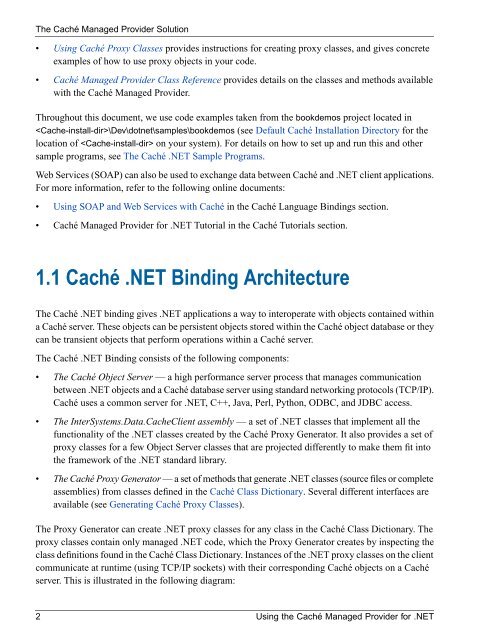Using the Caché Managed Provider for .NET - InterSystems ...
Using the Caché Managed Provider for .NET - InterSystems ...
Using the Caché Managed Provider for .NET - InterSystems ...
- No tags were found...
You also want an ePaper? Increase the reach of your titles
YUMPU automatically turns print PDFs into web optimized ePapers that Google loves.
The <strong>Caché</strong> <strong>Managed</strong> <strong>Provider</strong> Solution• <strong>Using</strong> <strong>Caché</strong> Proxy Classes provides instructions <strong>for</strong> creating proxy classes, and gives concreteexamples of how to use proxy objects in your code.• <strong>Caché</strong> <strong>Managed</strong> <strong>Provider</strong> Class Reference provides details on <strong>the</strong> classes and methods availablewith <strong>the</strong> <strong>Caché</strong> <strong>Managed</strong> <strong>Provider</strong>.Throughout this document, we use code examples taken from <strong>the</strong> bookdemos project located in\Dev\dotnet\samples\bookdemos (see Default <strong>Caché</strong> Installation Directory <strong>for</strong> <strong>the</strong>location of on your system). For details on how to set up and run this and o<strong>the</strong>rsample programs, see The <strong>Caché</strong> .<strong>NET</strong> Sample Programs.Web Services (SOAP) can also be used to exchange data between <strong>Caché</strong> and .<strong>NET</strong> client applications.For more in<strong>for</strong>mation, refer to <strong>the</strong> following online documents:• <strong>Using</strong> SOAP and Web Services with <strong>Caché</strong> in <strong>the</strong> <strong>Caché</strong> Language Bindings section.• <strong>Caché</strong> <strong>Managed</strong> <strong>Provider</strong> <strong>for</strong> .<strong>NET</strong> Tutorial in <strong>the</strong> <strong>Caché</strong> Tutorials section.1.1 <strong>Caché</strong> .<strong>NET</strong> Binding ArchitectureThe <strong>Caché</strong> .<strong>NET</strong> binding gives .<strong>NET</strong> applications a way to interoperate with objects contained withina <strong>Caché</strong> server. These objects can be persistent objects stored within <strong>the</strong> <strong>Caché</strong> object database or <strong>the</strong>ycan be transient objects that per<strong>for</strong>m operations within a <strong>Caché</strong> server.The <strong>Caché</strong> .<strong>NET</strong> Binding consists of <strong>the</strong> following components:• The <strong>Caché</strong> Object Server — a high per<strong>for</strong>mance server process that manages communicationbetween .<strong>NET</strong> objects and a <strong>Caché</strong> database server using standard networking protocols (TCP/IP).<strong>Caché</strong> uses a common server <strong>for</strong> .<strong>NET</strong>, C++, Java, Perl, Python, ODBC, and JDBC access.• The <strong>InterSystems</strong>.Data.CacheClient assembly — a set of .<strong>NET</strong> classes that implement all <strong>the</strong>functionality of <strong>the</strong> .<strong>NET</strong> classes created by <strong>the</strong> <strong>Caché</strong> Proxy Generator. It also provides a set ofproxy classes <strong>for</strong> a few Object Server classes that are projected differently to make <strong>the</strong>m fit into<strong>the</strong> framework of <strong>the</strong> .<strong>NET</strong> standard library.• The <strong>Caché</strong> Proxy Generator — a set of methods that generate .<strong>NET</strong> classes (source files or completeassemblies) from classes defined in <strong>the</strong> <strong>Caché</strong> Class Dictionary. Several different interfaces areavailable (see Generating <strong>Caché</strong> Proxy Classes).The Proxy Generator can create .<strong>NET</strong> proxy classes <strong>for</strong> any class in <strong>the</strong> <strong>Caché</strong> Class Dictionary. Theproxy classes contain only managed .<strong>NET</strong> code, which <strong>the</strong> Proxy Generator creates by inspecting <strong>the</strong>class definitions found in <strong>the</strong> <strong>Caché</strong> Class Dictionary. Instances of <strong>the</strong> .<strong>NET</strong> proxy classes on <strong>the</strong> clientcommunicate at runtime (using TCP/IP sockets) with <strong>the</strong>ir corresponding <strong>Caché</strong> objects on a <strong>Caché</strong>server. This is illustrated in <strong>the</strong> following diagram:2 <strong>Using</strong> <strong>the</strong> <strong>Caché</strong> <strong>Managed</strong> <strong>Provider</strong> <strong>for</strong> .<strong>NET</strong>
















